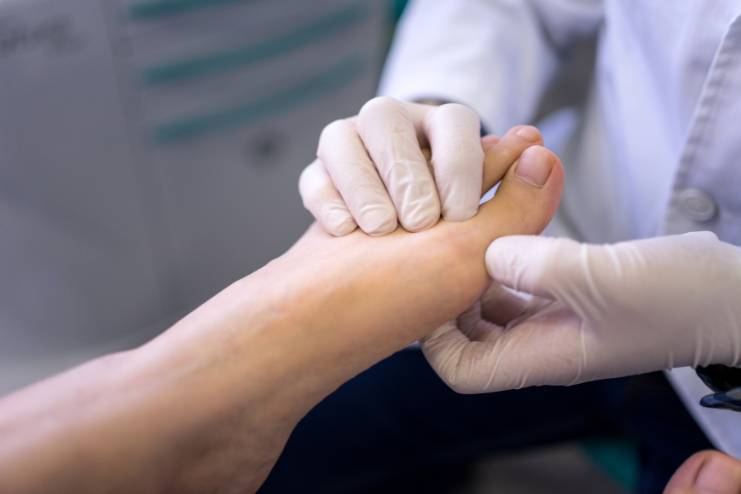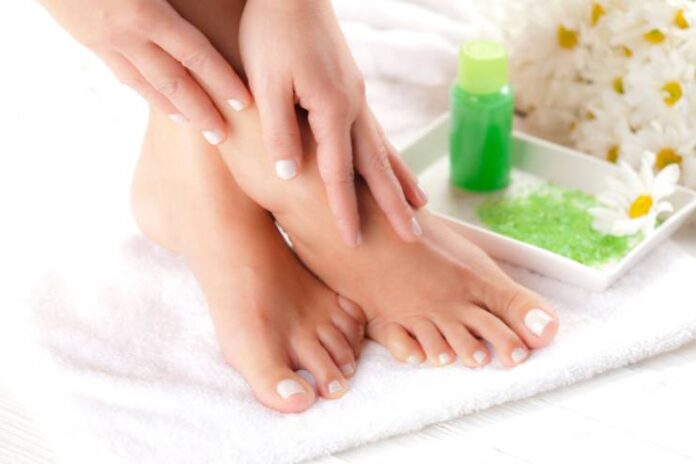Affiliate Disclaimer
Some links in this article are affiliate links. We may earn a small commission if you make a purchase through these links, at no extra cost to you. We only recommend products we find useful to our readersDiabetes is not confined to your blood sugar levels; it affects almost every function and every part of your body. From the heart, lungs, kidneys, and nerves, it also slows down the healing process and affects every body part.
Diabetes causes nerve damage, which makes the feet numb and also impairs the foot’s skin. When the nerves are damaged, the blood oxygen supply to our feet gets significantly reduced. Damaged nerves may not be able to carry signals to the brain, and you may experience tingling, numbness, and slower healing of foot wounds. When severe, it may require an amputation.
This loss of feeling and sensation in your feet due to diabetes is called peripheral neuropathy. This causes foot injuries not to heal, and thus, foot care is critical to prevent any complications from diabetes.
Diabetic Foot Care

Foot infections in diabetics must be treated properly and with care, as even something as simple as cracked feet may result in other complications. If there is numbness and pain simultaneously, steps must be taken for diabetes foot pain relief. Some important tips for diabetes foot care are:
- Get a Diabetes Foot Checkup with Your Healthcare Provider
Early detection may help manage and prevent complications. The doctor will look for any deformity or problems in your feet and recommend treatment measures to prevent progression to a more severe condition.
- Inspect Your Feet Well
Examine your feet daily for cuts, wounds, or bruises, none of which should be left untreated. Check your toes, tops, sides, heels, soles, and areas between your toes. Be sure you can see all areas clearly. Use a mirror or ask someone for help if necessary.
- Wash and Keep Your Feet Clean
Wash your feet every time you come from outdoors and soak them in salted warm water every few days; this kills the germs and prevents the spread of any infections. Wash your feet with mild soap and warm water every day. You may have numbness in your feet and may not actually feel the temperature of the water when you wash your feet, so check the temperature with a finger or elbow before you dip your feet in.
- Thoroughly Dry Your Feet After Washing
Preventing diabetic foot complications requires special attention to keeping the feet dry after washing them. Taking proper care of the feet of diabetics entails the maintenance of cleanliness and being free from moisture to prevent germ and infection-causing microorganisms. Remember to pat your feet dry thoroughly after every wash, paying particular attention to the spaces between your toes and other folds.
- Moisturize Your Feet Regularly
Keep your feet well-moisturized. This will prevent dryness, which may cause cracks that could increase the risk of having diabetic complications on your feet. However, it is good to avoid applying lotions on the areas between your toes since excessive moisture in those areas tends to promote infections.
- Wear Shoes That Fit Well
Overly tight or big shoes can easily spark off a case of diabetic foot disease. A minor shoe bite could escalate and become a major infection. Opt for shoes that offer a good fit. Be comfortable and supportive of your feet. If you are suffering from diabetes, then poorly fitting shoes can result in ulcers, corns, and calluses, which could be challenging to treat. Your shoes must be comfortable and protective enough to ensure the good health of your feet.
- Cut and File Your Toenails Regularly
It is important to keep your toenails trimmed and filed without any cuts. Even minor cuts or nicks could lead to significant troubles for diabetics, so nail clipping is part of the measures taken to prevent damage and keep feet healthy.
- Never Walk Barefoot
Diabetics should not walk barefoot because this exposes them to cuts and wounds that may precipitate more severe complications. Always wear closed shoes for maximum protection for your feet. Ensure that your feet are well-covered and supported to prevent damage and maintain the health of your feet.
- Keep Your Feet Level with Your Seat
Keep your feet flat on the floor instead of dangling or crossing at the legs, interrupting blood flow to your feet. Blood flow is needed to keep your feet healthy, especially if you have diabetes. Maintain a balanced and relaxed sitting position to ensure proper blood supply to your feet and to reduce possible complications.
- Incorporate Regular Walking and Exercise for Your Feet
Regular walking and exercise help maintain blood flow. Both of these are essential for diabetics. It makes one’s feet stronger and prevents numbness. However, refrain from exercising if you have sores or ulcers on your feet, as it can exacerbate the condition.
- Avoid Smoking to Protect Your Feet
Smoking affects blood circulation, causing further foot and leg complications. Avoid smoking to keep your blood circulation going and, thus, protect your feet.
When Should You See Your Doctor?

For a diabetic, having a wound that does not heal within a short period is enough to seek a podiatrist or specialist. To help treat a diabetic foot and know when to visit your doctor, here are some symptoms to consider:
- If you see breaks around your wounds and they don’t heal
- There is continuous discharge from the wound
- The skin on your foot has changed and looks pale, reddish, or has a bluish tone
- There is swelling in your feet around a blister or injury, which does not seem to fade
- Redness and pus on a blister
- There is cracking between the toes, similar to athlete’s foot
- Increase in numbness or pain
- Infections around sores and injuries
- Hammertoes, when the middle joint of your toes is permanently bent down.
Foot care for diabetic patients starts with taking preventive measures. Both diabetic foot care tips and recognizing diabetic foot symptoms are crucial. Various factors can cause diabetic foot issues, such as injuries, ill-fitting footwear, or improper foot positions, which are often triggered by poor blood flow due to diabetes affecting nerve function. Prioritizing foot care is essential for those with diabetes, and you should consult your podiatrist for any minor injury.
-
Nov 2017Written by Minu Manisha
-
Sep 2024Edited by Laxmi Gayatri
In this Article




















